An Evaluation of CRA40 and ERA5 Precipitation Products over China
Abstract
:1. Introduction
2. Materials and Methods
2.1. Study Area
2.2. Ground Reference Data
2.3. CRA40
2.4. ERA5
2.5. Evaluation Methods and Metrics
3. Results
3.1. 13-Year Daily Mean Precipitation
3.2. Seasonal Daily Mean Precipitation
3.3. Daily Precipitation
3.4. Probability Distributions by Occurrence and Precipitation Volume
3.5. Daily Precipitation Detection Capability
3.6. Spatial Analysis
4. Discussion
5. Summary
- (1)
- CRA40 performs better than ERA5 across mainland China in terms of the 13-year daily average precipitation. Compared to ERA5, CRA40 exhibits a higher CC (0.97), a smaller RB (5.25%), a lower RMSE (0.34 mm), and a smaller FSE (0.05), while ERA5 has a lower CC (0.91), a larger RB (18.59%), a slightly higher RMSE (0.75 mm), and a higher FSE (0.24). Both CRA40 and ERA5 show less overestimation of precipitation in wet regions (CJ and HN), but exhibit more pronounced overestimation in high-altitude and dry climatic regions (QZ and XJ). Additionally, CRA40 generally had smaller RB and RMSE values in wetter regions and higher CC values compared to ERA5, except in XJ, where the CC values are slightly lower than ERA5.
- (2)
- Seasonally, CRA40 has less overestimation and higher CC in areas with abundant precipitation over southeastern China (HN, CJ, and HB). The RB values of ERA5 are relatively large in all seasons (22.93%, 12.81%, 20.32%, and 36.54%), while CRA40 exhibits only slight overestimation in all seasons (6.89%, 4.77%, 3.74%, 6.86%). Additionally, CRA40 had high CC values (≥0.93), while ERA5 had lower CC values (≥0.84).
- (3)
- ERA5 precipitation products have better quality than CRA40, and are more suitable for daily-scale precipitation studies in mainland China and its sub-divisions. Although the daily bias of ERA5 is relatively large, it has higher daily series CC values, which can better reflect the characteristics and variations in precipitation events and provide a reliable basis for the assessment of precipitation (Figure 6).
- (4)
- The analysis of probability density functions for sporadic precipitation (<1 mm/day) and light to medium rainfall (1–25 mm/day) shows that CRA40 better captured these categories, whereas ERA5 performs better in capturing heavy precipitation (>30 mm/day). Both CRA40 and ERA5 underestimate trace and heavy rainfall and overestimate light and moderate rainfall, with CRA40 underestimating heavy precipitation to a greater extent.
- (5)
- ERA5 exhibits better contingency statistics than CRA40, with a higher POD and CIS and a lower FAR for most threshold intervals. Both CRA40 and ERA5 have poor performance in detecting high precipitation rates.
- (6)
- Both CRA40 and ERA5 exhibit better performance in estimating precipitation during the spring, summer, and autumn seasons compared to winter. For most of the time, both CRA40 and ERA5 demonstrate a pronounced overestimation, particularly in the QZ region at higher altitudes. CRA40 shows a lower level of overestimation (51.62%) during winter in comparison to ERA5 (299.84%), but its CC (0.36) is lower than that of ERA5 (0.76) (Figure 4 and Figure 5 and Table 3).
- (7)
- In the high-altitude QZ region, the quality of CRA40 precipitation products is poor in winter, showing a low correlation, while CRA40’s product quality is better than ERA5 in the other three seasons. In the arid area of XJ with sparse precipitation, ERA5 is more suitable than CRA40. Although ERA5 has a relatively large relative deviation, it generally has a higher correlation. In the YG, CJ, and HN regions, where precipitation is abundant and the terrain is complex, CRA40 has better application potential than ERA5. In the XB, DB, and HB regions with less precipitation, except for the high deviation and relatively low correlation of ERA5 in winter in the XB region, the performance of CRA40 and ERA5 products is relatively stable and reliable (Table 3).
Author Contributions
Funding
Data Availability Statement
Acknowledgments
Conflicts of Interest
References
- Liu, Y.; Fu, Q.; Song, P.; Zhao, X.; Dou, C. Satellite Retrieval of Precipitation: An Overview. Adv. Earth Sci. 2011, 26, 1162–1172. [Google Scholar]
- Wang, C.; Hong, Y. Review on inversion, verification and application of satellite remote sensing of precipitation. Water Resour. Hydropower Eng. 2018, 49, 1–9. [Google Scholar] [CrossRef]
- Bárdossy, A.; Pegram, G. Interpolation of Precipitation under Topographic Influence at Different Time Scales: Interpolation of Precipitation. Water Resour. Res. 2013, 49, 4545–4565. [Google Scholar] [CrossRef]
- Tapiador, F.J.; Turk, F.J.; Petersen, W.; Hou, A.Y.; García-Ortega, E.; Machado, L.A.T.; Angelis, C.F.; Salio, P.; Kidd, C.; Huffman, G.J.; et al. Global Precipitation Measurement: Methods, Datasets and Applications. Atmos. Res. 2012, 104–105, 70–97. [Google Scholar] [CrossRef]
- Zhang, L.; Ren, D.; Nan, Z.; Wang, W.; Zhao, Y.; Zhao, Y.; Ma, Q.; Wu, X. Interpolated or Satellite-Based Precipitation? Implications for Hydrological Modeling in a Meso-Scale Mountainous Watershed on the Qinghai-Tibet Plateau. J. Hydrol. 2020, 583, 124629. [Google Scholar] [CrossRef]
- Guo, H.; Chen, S.; Bao, A.; Hu, J.; Gebregiorgis, A.; Xue, X.; Zhang, X. Inter-Comparison of High-Resolution Satellite Precipitation Products over Central Asia. Remote Sens. 2015, 7, 7181–7211. [Google Scholar] [CrossRef]
- Hao, Z.; Tong, K.; Liu, X.; Zheng, L. Capability of TMPA products to simulate streamflow in upper Yellow and Yangtze River basins on Tibetan Plateau. Water Sci. Eng. 2014, 7, 237–249. [Google Scholar]
- Bengtsson, L.; Shukla, J. Integration of Space and In Situ Observations to Study Global Climate Change. Bull. Am. Meteorol. Soc. 1988, 69, 1130–1143. [Google Scholar] [CrossRef]
- Wang, C.; Huang, A.; Zheng, P.; Liu, K.; Hou, M. Applicability Evaluation of China’s First Generation of Global Land Surface Reanalysis (CRA40/Land) Air Temperature and Precipitation Products in China Mainland. Plateau Meteorol. 2022, 41, 1325–1334. [Google Scholar]
- Ruane, A.C.; Goldberg, R.; Chryssanthacopoulos, J. Climate Forcing Datasets for Agricultural Modeling: Merged Products for Gap-Filling and Historical Climate Series Estimation. Agric. For. Meteorol. 2015, 200, 233–248. [Google Scholar] [CrossRef]
- Zhao, T.; Fu, C.; Ke, Z.; Guo, W. Global Atmosphere Reanalysis Datasets: Current Status and Recent Advances. Adv. Earth Sci. 2010, 25, 242–254. [Google Scholar]
- Vousdoukas, M.I.; Voukouvalas, E.; Annunziato, A.; Giardino, A.; Feyen, L. Projections of Extreme Storm Surge Levels along Europe. Clim. Dyn. 2016, 47, 3171–3190. [Google Scholar] [CrossRef]
- Uppala, S.S.; Kallberg, P.; Simmons, A.; Andrae, U.; Bechtold, V.; Fiorino, M.; Gibson, J.; Haseler, J.; Hernandez-Carrascal, A.; Kelly, G.; et al. The ERA-40 Reanalysis. Q. J. R. Meteor. Soc. 2005, 131, 2961–3012. [Google Scholar] [CrossRef]
- Dee, D.P.; Uppala, S.M.; Simmons, A.J.; Berrisford, P.; Poli, P.; Kobayashi, S.; Andrae, U.; Balmaseda, M.A.; Balsamo, G.; Bauer, P.; et al. The ERA-Interim Reanalysis: Configuration and Performance of the Data Assimilation System. Q. J. R. Meteorol. Soc. 2011, 137, 553–597. [Google Scholar] [CrossRef]
- Onogi, K.; Tsutsui, J.; Koide, H.; Sakamoto, M.; Kobayashi, S.; Hatsushika, H.; Matsumoto, T.; Yamazaki, N.; Kamahori, H.; Takahashi, K.; et al. The JRA-25 Reanalysis. J. Meteorol. Soc. Jpn. 2007, 85, 369–432. [Google Scholar] [CrossRef]
- Kobayashi, S.; Ota, Y.; Harada, Y.; Ebita, A.; Moriya, M.; Onoda, H.; Onogi, K.; Kamahori, H.; Kobayashi, C.; Endo, H.; et al. The JRA-55 Reanalysis: General Specifications and Basic Characteristics. J. Meteorol. Soc. Jpn. Ser. II 2015, 93, 5–48. [Google Scholar] [CrossRef]
- Rienecker, M.M.; Suarez, M.J.; Gelaro, R.; Todling, R.; Bacmeister, J.; Liu, E.; Bosilovich, M.G.; Schubert, S.D.; Takacs, L.; Kim, G.-K.; et al. MERRA: NASA’s Modern-Era Retrospective Analysis for Research and Applications. J. Clim. 2011, 24, 3624–3648. [Google Scholar] [CrossRef]
- Chen, Z.; Zhou, Z.; Liu, Z.; Li, Q.; Zhang, X. Bias Adjustment and Analysis of Chinese Daily Historical Radiosonde Temperature Data. J. Meteorol. Res. 2021, 35, 17–31. [Google Scholar] [CrossRef]
- Liao, J.; Wang, H.; Zhou, Z.; Liu, Z.; Jiang, L.; Yuan, F. Integration, Quality Assurance, and Usage of Global Aircraft Observations in CRA. J. Meteorol. Res. 2021, 35, 1–16. [Google Scholar] [CrossRef]
- Wang, M.; Yao, S.; Jiang, L.; Liu, Z.; Shi, C.; Hu, K.; Zhang, T.; Zhang, Z.; Liu, J. Collection and Pre-Processing of Satellite Remote-Sensing Data in CRA-40 (CMA’s Global Atmospheric ReAnalysis). Adv. Meteorol. Sci. Technol. 2018, 8, 158–163. [Google Scholar]
- Wang, M.; Yao, S.; Jiang, L.; Zhang, T.; SHI, C.; ZHU, T. Pre-Processing, Quality Assurance, and Use of Global Atmospheric Motion Vector Observations in CRA. J. Meteorol. Res. 2022, 36, 947–962. [Google Scholar] [CrossRef]
- Dutra, E.; Viterbo, P.; Miranda, P.M.A. ERA-40 Reanalysis Hydrological Applications in the Characterization of Regional Drought. Geophys. Res. Lett. 2008, 35, L19402. [Google Scholar] [CrossRef]
- Bengtsson, L.; Arkin, P.; Berrisford, P.; Bougeault, P.; Folland, C.K.; Gordon, C.; Haines, K.; Hodges, K.I.; Jones, P.; Kallberg, P.; et al. The Need for A Dynamical Climate Reanalysis. Bull. Am. Meteorol. Soc. 2007, 88, 495–501. [Google Scholar] [CrossRef]
- Wu, J.; Hui, P.; Liu, J.; Tang, J. The spatio-temporal features of precipitation extremes in the Yangtze-Huaihe River Basin: A comparison between observation and reanalysis. Trans. Atmos. Sci. 2019, 42, 207–220. [Google Scholar] [CrossRef]
- Xin, Y.; Lu, N.; Jiang, H.; Liu, Y.; Yao, L. Performance of ERA5 Reanalysis Precipitation Products in the Guangdong-Hong Kong-Macao Greater Bay Area, China. J. Hydrol. 2021, 602, 126791. [Google Scholar] [CrossRef]
- Jiang, S.; Wei, L.; Ren, L.; Zhang, L.; Wang, M.; Cui, H. Evaluation of IMERG, TMPA, ERA5, and CPC Precipitation Products over Mainland China: Spatiotemporal Patterns and Extremes. Water Sci. Eng. 2023, 16, 45–56. [Google Scholar] [CrossRef]
- Qu, X.; Wang, H.; Wu, N.; Sun, X.; Liu, P.; Song, H. Applicability Analysis of Four Reanalysis Monthly Precipitation Data in Inner Mongolia. Mid-Low Latit. Mt. Meteorol. 2023, 47, 75–81. [Google Scholar]
- Li, C.; Zhao, T.; Shi, C.; Liu, Z. Evaluation of Daily Precipitation Product in China from the CMA Global Atmospheric Interim Reanalysis. J. Meteorol. Res. 2020, 34, 117–136. [Google Scholar] [CrossRef]
- Huang, X.; Wu, W.; Xu, J.; Li, S.; Jiang, Y.; Du, B.; Wang, L. The Applicability Performance of the ERA5-Land Precipitation Datasets in Southwest China. Available online: http://kns.cnki.net/kcms/detail/62.1061.p.20231024.1817.004.html (accessed on 5 November 2023).
- Jiang, Q.; Li, W.; Fan, Z.; He, X.; Sun, W.; Chen, S.; Wen, J.; Gao, J.; Wang, J. Evaluation of the ERA5 Reanalysis Precipitation Dataset over Chinese Mainland. J. Hydrol. 2021, 595, 125660. [Google Scholar] [CrossRef]
- Chen, S.; Hong, Y.; Cao, Q.; Gourley, J.; Kirstetter, P.-E.; Yong, B.; Tian, Y.; Zhang, Z.; Shen, Y.; Hu, J. Similarity and Difference of the Two Successive V6 and V7 TRMM Multisatellite Precipitation Analysis Performance over China. J. Geophys. Res. Atmos. 2013, 118, 13060–13074. [Google Scholar] [CrossRef]
- Zhu, R.; Li, L.; Wang, H.; Gan, H. Comparative Study on the Spatial Variability of Rainfall and Its Spatial Interpolation Methods. China Rural Water Hydropower 2004, 1, 25–28. [Google Scholar]
- Tang, G.; Behrangi, A.; Long, D.; Li, C.; Hong, Y. Accounting for Spatiotemporal Errors of Gauges: A Critical Step to Evaluate Gridded Precipitation Products. J. Hydrol. 2018, 559, 294–306. [Google Scholar] [CrossRef]
- Han, W.S.; Burian, S.J.; Shepherd, J.M. Assessment of Satellite-Based Rainfall Estimates in Urban Areas in Different Geographic and Climatic Regions. Nat. Hazards 2011, 56, 733–747. [Google Scholar] [CrossRef]
- Yu, C.; Hu, D.; Liu, M.; Wang, S.; Di, Y. Spatio-Temporal Accuracy Evaluation of Three High-Resolution Satellite Precipitation Products in China Area. Atmos. Res. 2020, 241, 104952. [Google Scholar] [CrossRef]
- Zhang, L.; Li, X.; Cao, Y.; Nan, Z.; Wang, W.; Ge, Y.; Wang, P.; Yu, W. Evaluation and Integration of the Top-down and Bottom-up Satellite Precipitation Products over Mainland China. J. Hydrol. 2020, 581, 124456. [Google Scholar] [CrossRef]
- Lu, D.; Yong, B. A Preliminary Assessment of the Gauge-Adjusted Near-Real-Time GSMaP Precipitation Estimate over Mainland China. Remote Sens. 2020, 12, 141. [Google Scholar] [CrossRef]
- GB/T 28592—2012; Grade of Precipitation. Standards Press of China: Beijing, China, 2012; pp. 1–2.
- Zhu, H.; Chen, S.; Li, X.; Li, Z. Assessment on error of GPM satellite-based precipitation products during “7·21” extreme rainstorm in Henan. Water Resour. Hydropower Eng. 2022, 53, 1–13. [Google Scholar] [CrossRef]
- Tian, Y.; Peters-Lidard, C.D.; Choudhury, B.J.; Garcia, M. Multitemporal Analysis of TRMM-Based Satellite Precipitation Products for Land Data Assimilation Applications. J. Hydrometeorol. 2007, 8, 1165–1183. [Google Scholar] [CrossRef]
- Amjad, M.; Yilmaz, M.T.; Yucel, I.; Yilmaz, K.K. Performance Evaluation of Satellite- and Model-Based Precipitation Products over Varying Climate and Complex Topography. J. Hydrol. 2020, 584, 124707. [Google Scholar] [CrossRef]
- Quan, C.; Zhou, B.; Shen, X.; Shen, Y.; Zhu, S.; Zhao, T. Applicability Evaluation of IMERG and GSMaP Satellite Precipitation Data in the Three-River Source Region. Plateau Mt. Meteorol. Res. 2022, 42, 102–108. [Google Scholar]
- Fallah, A.; Rakhshandehroo, G.R.; Berg, P.O.S.; Orth, R. Evaluation of Precipitation Datasets against Local Observations in Southwestern Iran. Int. J. Climatol. 2020, 40, 4102–4116. [Google Scholar] [CrossRef]
- Nogueira, M. Inter-Comparison of ERA-5, ERA-Interim and GPCP Rainfall over the Last 40 Years: Process-Based Analysis of Systematic and Random Differences. J. Hydrol. 2020, 583, 124632. [Google Scholar] [CrossRef]
- Hénin, R.; Liberato, M.; Ramos, A.; Gouveia, C. Assessing the Use of Satellite-Based Estimates and High-Resolution Precipitation Datasets for the Study of Extreme Precipitation Events over the Iberian Peninsula. Water 2018, 10, 1688. [Google Scholar] [CrossRef]
- Sharifi, E.; Eitzinger, J.; Dorigo, W. Performance of the State-Of-The-Art Gridded Precipitation Products over Mountainous Terrain: A Regional Study over Austria. Remote Sens. 2019, 11, 2018. [Google Scholar] [CrossRef]
- Gao, H.; Li, G. Mesoscale Synoptic Meteorology Analysis and Numerical Experiment of Local Sudden Rainstorm Affected by Topography in Southeast Part of Guizhou Province. Plateau Meteorol. 2020, 39, 301–310. [Google Scholar]
- Li, W.; Sun, W.; He, X.; Scaioni, M.; Yao, D.; Chen, Y.; Gao, J.; Li, X.; Cheng, G. Improving CHIRPS Daily Satellite-Precipitation Products Using Coarser Ground Observations. IEEE Geosci. Remote Sens. Lett. 2019, 16, 1678–1682. [Google Scholar] [CrossRef]
- Wang, N.; Liu, W.; Sun, F.; Yao, Z.; Wang, H.; Liu, W. Evaluating Satellite-Based and Reanalysis Precipitation Datasets with Gauge-Observed Data and Hydrological Modeling in the Xihe River Basin, China. Atmos. Res. 2020, 234, 104746. [Google Scholar] [CrossRef]
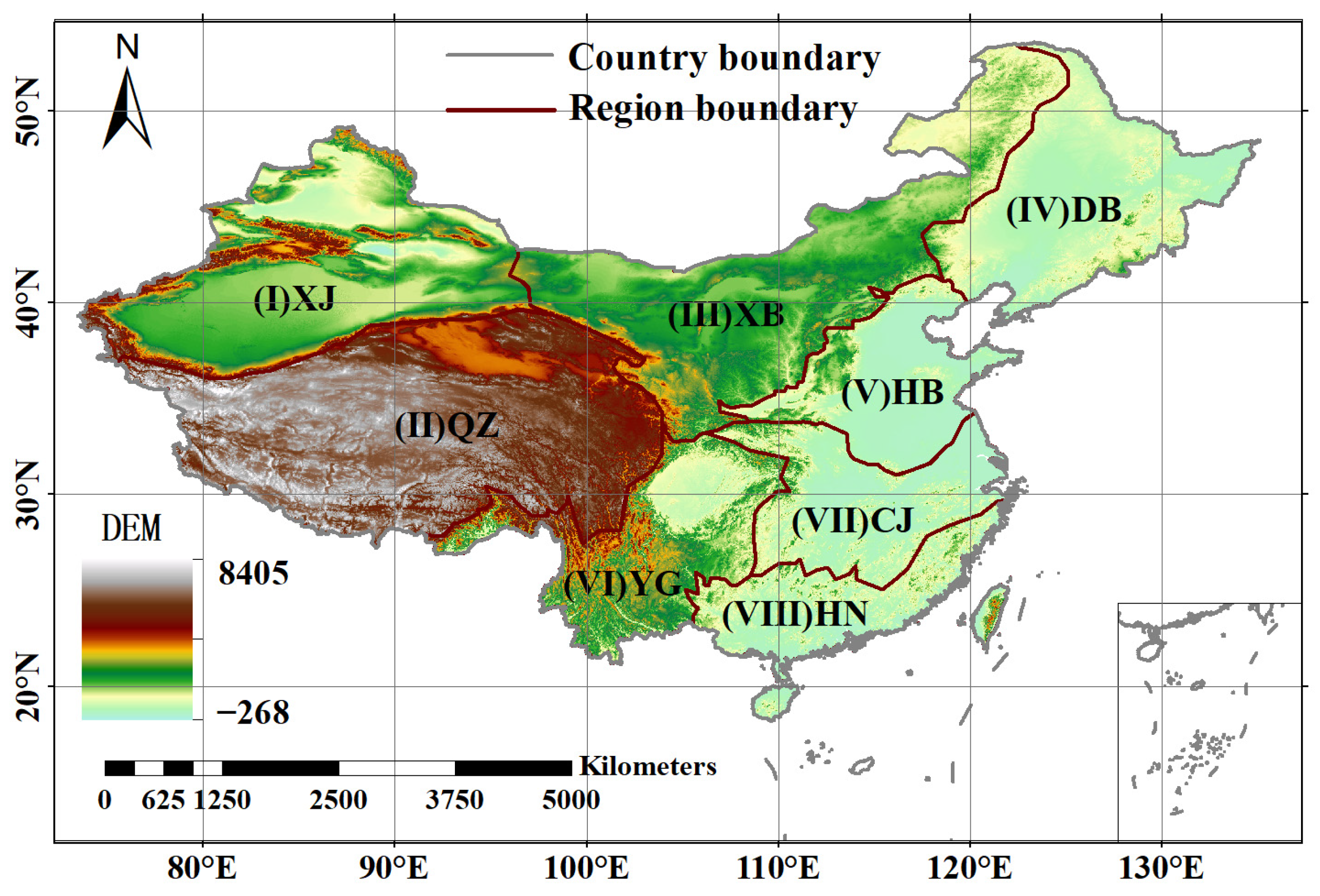
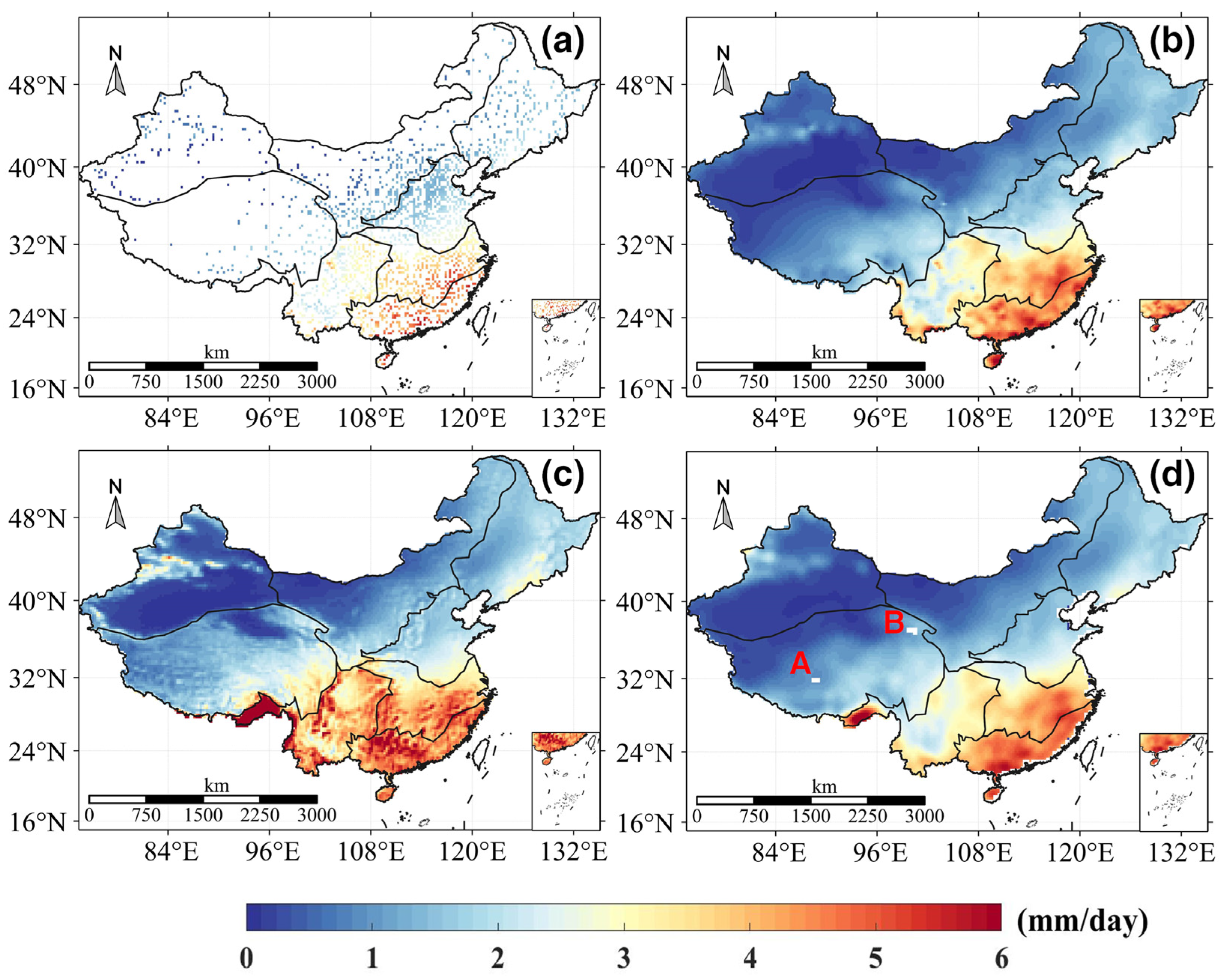
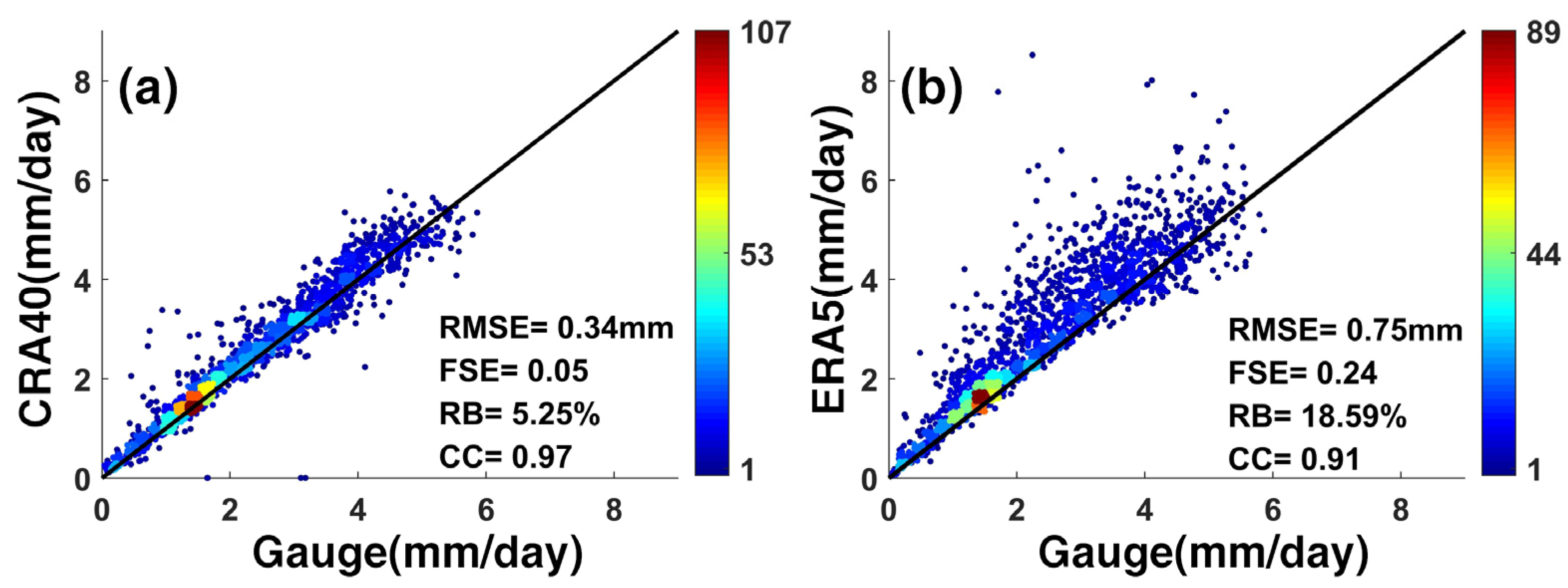
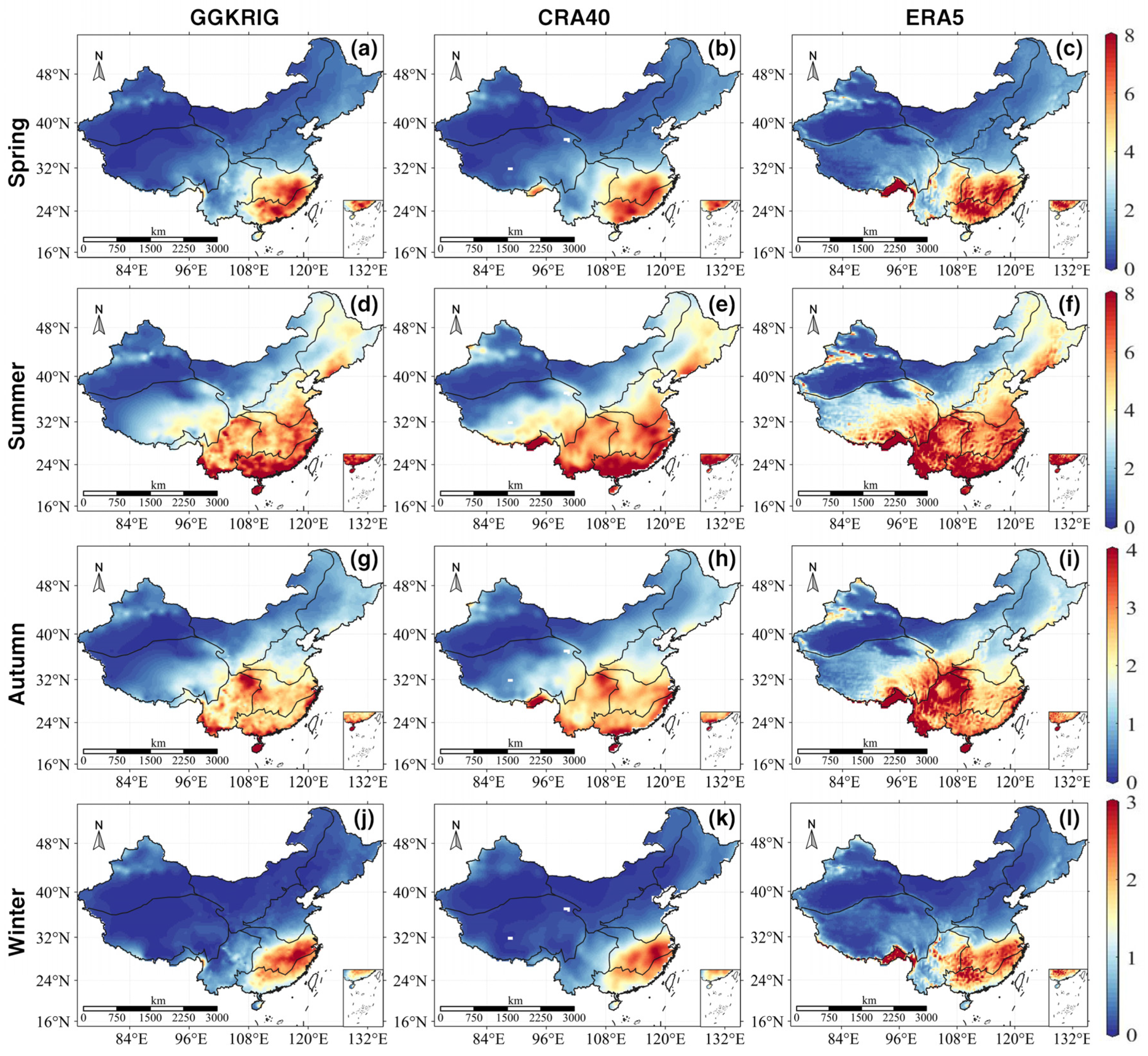
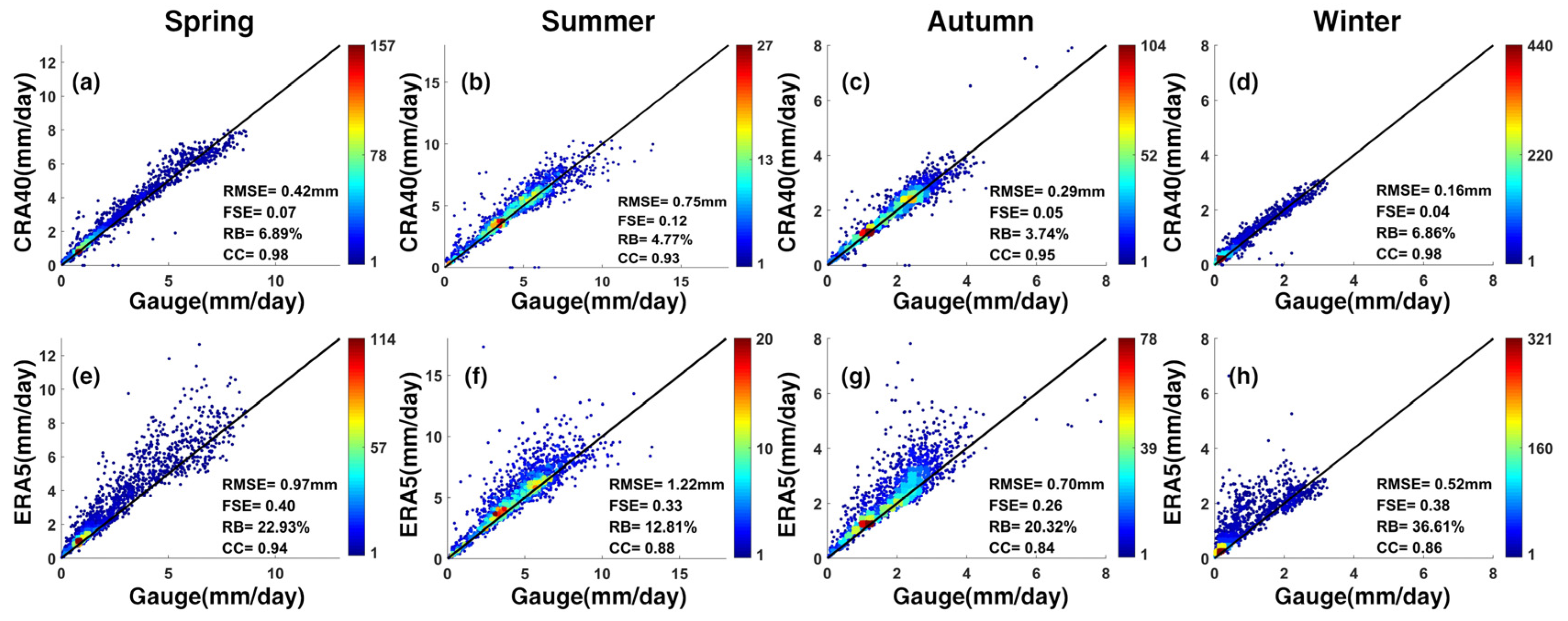


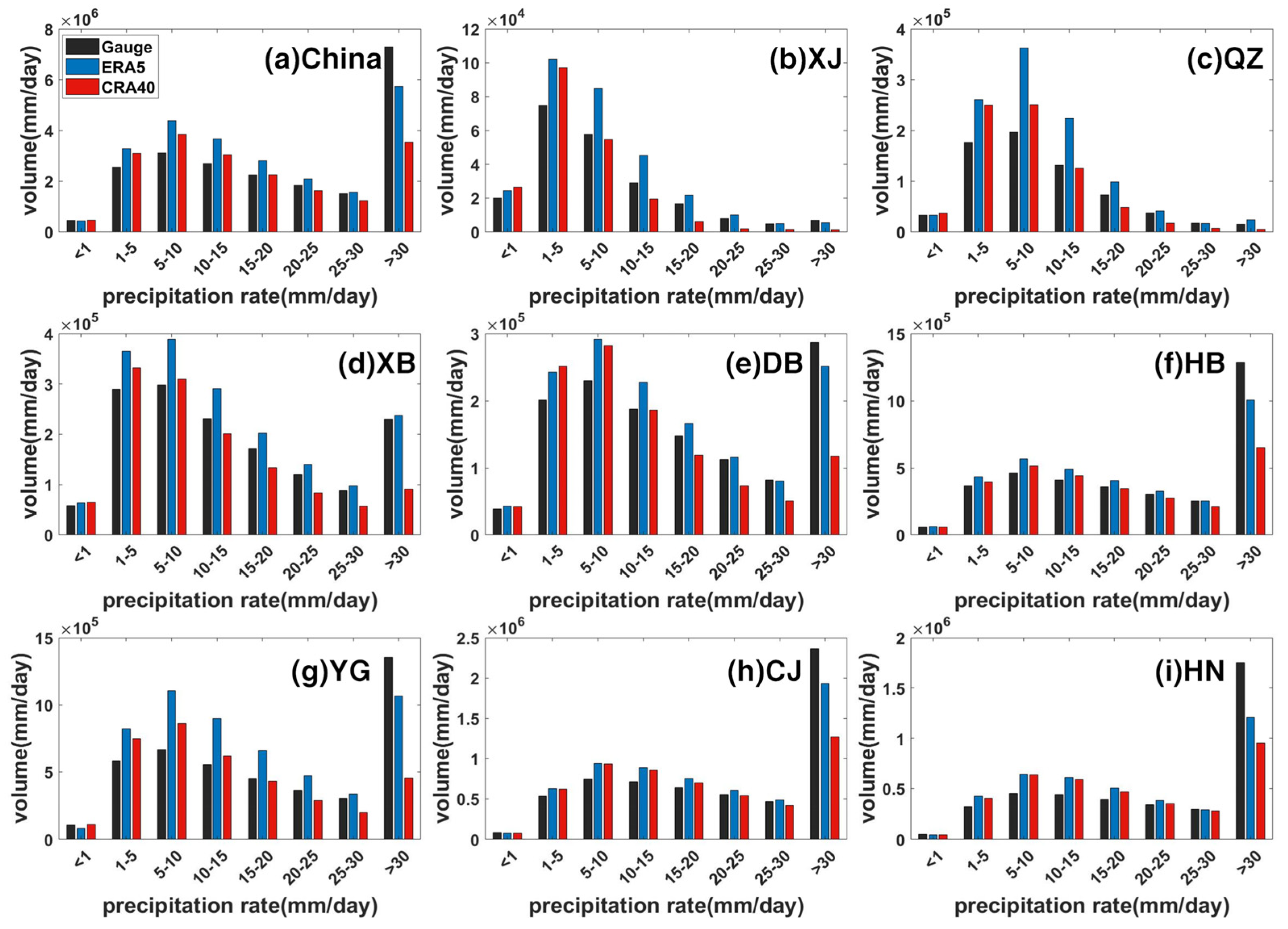

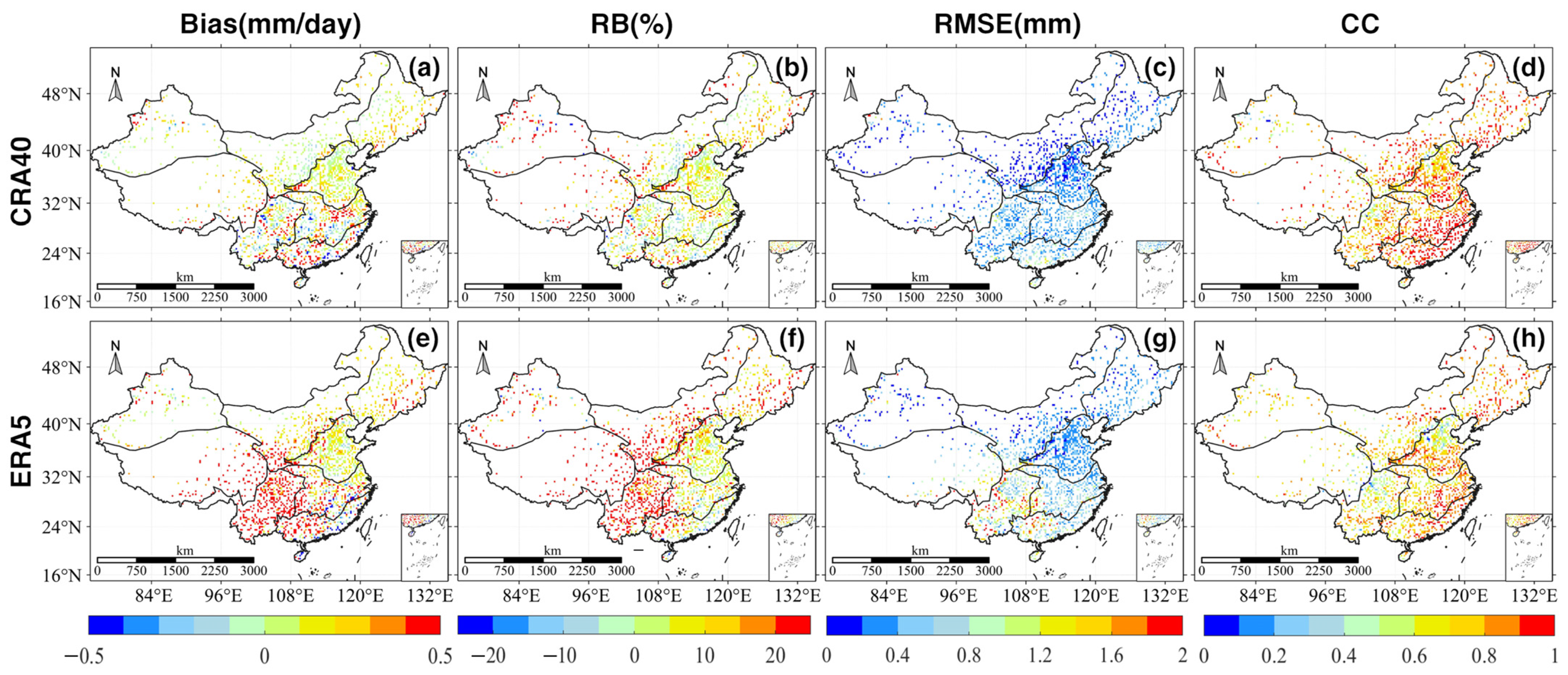
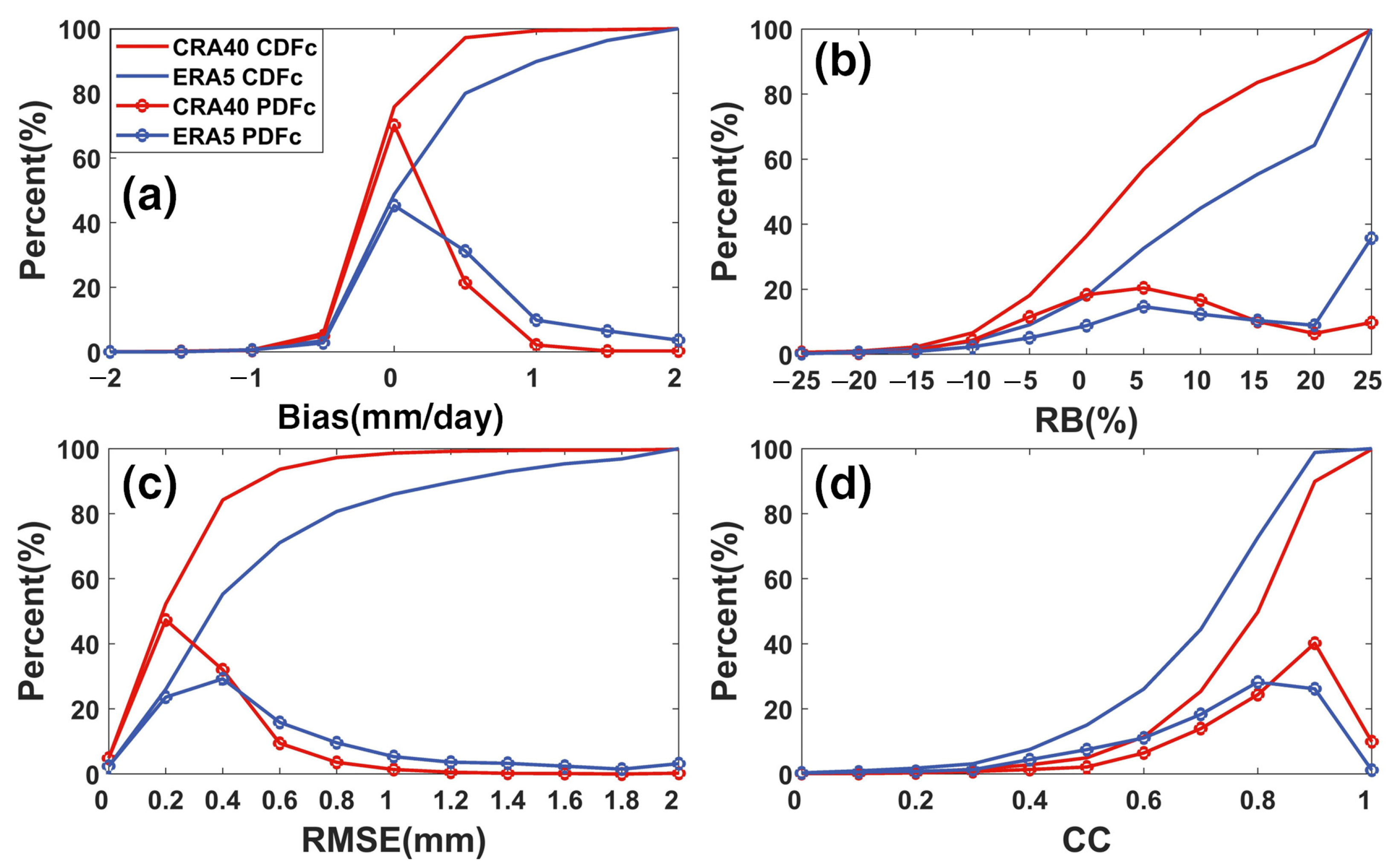
| Evaluation Indicators | Formula | Range of Values | Optimal Value | Unit |
|---|---|---|---|---|
| Bias | (−∞, ∞) | 0 | mm/day | |
| RMSE | (−∞, ∞) | 0 | mm/day | |
| RB | [0, ∞) | 0 | % | |
| CC | [−1, 1] | 1 | / | |
| FSE | [0, ∞) | 0 | / | |
| POD | [0, 1] | 1 | / | |
| FAR | [0, 1] | 0 | / | |
| CSI | [0, 1] | 1 | / |
| Class | Intensity (mm/day) | Rank |
|---|---|---|
| 1 | 1~10 | Light Rain |
| 2 | 10~25 | Medium Rain |
| 3 | 25~50 | Heavy Rain |
| 4 | 50~100 | Rainstorm |
| 5 | 100~250 | Large Rainstorm |
| 6 | ≥250 | Extreme Rainstorm |
| Indexes | Time | Type | China | XJ | QZ | XB | DB | HB | YG | CJ | HN |
|---|---|---|---|---|---|---|---|---|---|---|---|
| RMSE | 13 years | CRA40 | 0.34 | 0.41 | 0.51 | 0.16 | 0.21 | 0.20 | 0.37 | 0.38 | 0.49 |
| ERA5 | 0.75 | 0.50 | 1.21 | 0.43 | 0.29 | 0.30 | 1.30 | 0.61 | 0.86 | ||
| Spring | CRA40 | 0.41 | 0.44 | 0.44 | 0.13 | 0.19 | 0.17 | 0.50 | 0.47 | 0.77 | |
| ERA5 | 0.97 | 0.50 | 0.98 | 0.36 | 0.37 | 0.21 | 1.42 | 1.08 | 1.71 | ||
| Summer | CRA40 | 0.75 | 0.88 | 1.18 | 0.37 | 0.49 | 0.50 | 0.81 | 0.78 | 1.14 | |
| ERA5 | 1.22 | 1.02 | 2.44 | 0.69 | 0.48 | 0.69 | 1.92 | 0.92 | 1.22 | ||
| Autumn | CRA40 | 0.29 | 0.29 | 0.41 | 0.15 | 0.15 | 0.14 | 0.34 | 0.33 | 0.47 | |
| ERA5 | 0.70 | 0.43 | 1.13 | 0.57 | 0.27 | 0.28 | 1.30 | 0.37 | 0.56 | ||
| Winter | CRA40 | 0.16 | 0.13 | 0.14 | 0.04 | 0.09 | 0.09 | 0.21 | 0.23 | 0.23 | |
| ERA5 | 0.52 | 0.17 | 0.41 | 0.19 | 0.15 | 0.12 | 1.02 | 0.45 | 0.61 | ||
| RB (%) | 13 years | CRA40 | 5.25 | 31.40 | 23.12 | 6.92 | 11.04 | 5.13 | 2.65 | 2.95 | 4.51 |
| ERA5 | 18.59 | 49.35 | 70.87 | 28.91 | 16.15 | 8.94 | 36.67 | 8.83 | 8.72 | ||
| Spring | CRA40 | 6.89 | 27.58 | 29.34 | 10.46 | 14.37 | 8.39 | 9.51 | 3.24 | 4.42 | |
| ERA5 | 22.93 | 58.79 | 78.34 | 40.03 | 30.69 | 9.46 | 45.37 | 12.87 | 16.20 | ||
| Summer | CRA40 | 4.77 | 52.49 | 21.24 | 6.25 | 8.58 | 4.64 | 0.77 | 3.49 | 2.71 | |
| ERA5 | 12.81 | 40.59 | 56.05 | 16.76 | 7.53 | 8.47 | 21.94 | 8.65 | 1.15 | ||
| Autumn | CRA40 | 3.74 | 13.04 | 20.30 | 5.20 | 11.45 | 1.07 | −1.44 | 2.55 | 8.75 | |
| ERA5 | 20.32 | 63.50 | 83.93 | 37.60 | 24.12 | 6.37 | 38.38 | 4.51 | 5.28 | ||
| Winter | CRA40 | 6.86 | −4.94 | 51.62 | 14.36 | 37.61 | 18.64 | 9.93 | 1.16 | 6.57 | |
| ERA5 | 36.61 | 33.86 | 299.84 | 120.62 | 61.94 | 23.73 | 141.78 | 4.88 | 24.40 | ||
| FSE | 13 years | CRA40 | 0.05 | 0.36 | 0.19 | 0.02 | 0.03 | 0.02 | 0.05 | 0.04 | 0.05 |
| ERA5 | 0.24 | 0.53 | 1.07 | 0.17 | 0.06 | 0.05 | 0.59 | 0.10 | 0.17 | ||
| Spring | CRA40 | 0.07 | 0.39 | 0.20 | 0.02 | 0.04 | 0.02 | 0.10 | 0.05 | 0.11 | |
| ERA5 | 0.40 | 0.51 | 0.98 | 0.18 | 0.13 | 0.04 | 0.83 | 0.25 | 0.53 | ||
| Summer | CRA40 | 0.12 | 1.00 | 0.44 | 0.06 | 0.06 | 0.06 | 0.11 | 0.11 | 0.17 | |
| ERA5 | 0.33 | 1.33 | 1.90 | 0.20 | 0.06 | 0.11 | 0.64 | 0.15 | 0.20 | ||
| Autumn | CRA40 | 0.05 | 0.23 | 0.15 | 0.02 | 0.02 | 0.01 | 0.05 | 0.04 | 0.08 | |
| ERA5 | 0.26 | 0.49 | 1.11 | 0.29 | 0.07 | 0.05 | 0.64 | 0.06 | 0.11 | ||
| Winter | CRA40 | 0.04 | 0.08 | 0.19 | 0.01 | 0.04 | 0.02 | 0.07 | 0.03 | 0.03 | |
| ERA5 | 0.38 | 0.13 | 1.56 | 0.32 | 0.10 | 0.04 | 1.84 | 0.11 | 0.23 | ||
| CC | 13 years | CRA40 | 0.97 | 0.68 | 0.80 | 0.95 | 0.95 | 0.95 | 0.75 | 0.88 | 0.69 |
| ERA5 | 0.91 | 0.74 | 0.74 | 0.90 | 0.93 | 0.88 | 0.50 | 0.80 | 0.40 | ||
| Spring | CRA40 | 0.98 | 0.67 | 0.88 | 0.95 | 0.94 | 0.98 | 0.88 | 0.97 | 0.89 | |
| ERA5 | 0.94 | 0.79 | 0.82 | 0.93 | 0.91 | 0.93 | 0.81 | 0.89 | 0.65 | ||
| Summer | CRA40 | 0.93 | 0.58 | 0.72 | 0.92 | 0.92 | 0.90 | 0.75 | 0.65 | 0.61 | |
| ERA5 | 0.88 | 0.67 | 0.61 | 0.87 | 0.91 | 0.85 | 0.57 | 0.66 | 0.59 | ||
| Autumn | CRA40 | 0.95 | 0.68 | 0.85 | 0.97 | 0.95 | 0.94 | 0.80 | 0.66 | 0.93 | |
| ERA5 | 0.84 | 0.75 | 0.83 | 0.90 | 0.94 | 0.88 | 0.43 | 0.75 | 0.83 | ||
| Winter | CRA40 | 0.98 | 0.77 | 0.36 | 0.86 | 0.94 | 0.99 | 0.69 | 0.96 | 0.93 | |
| ERA5 | 0.86 | 0.77 | 0.76 | 0.65 | 0.94 | 0.95 | 0.54 | 0.82 | 0.71 |
Disclaimer/Publisher’s Note: The statements, opinions and data contained in all publications are solely those of the individual author(s) and contributor(s) and not of MDPI and/or the editor(s). MDPI and/or the editor(s) disclaim responsibility for any injury to people or property resulting from any ideas, methods, instructions or products referred to in the content. |
© 2023 by the authors. Licensee MDPI, Basel, Switzerland. This article is an open access article distributed under the terms and conditions of the Creative Commons Attribution (CC BY) license (https://creativecommons.org/licenses/by/4.0/).
Share and Cite
Zhou, Z.; Chen, S.; Li, Z.; Luo, Y. An Evaluation of CRA40 and ERA5 Precipitation Products over China. Remote Sens. 2023, 15, 5300. https://doi.org/10.3390/rs15225300
Zhou Z, Chen S, Li Z, Luo Y. An Evaluation of CRA40 and ERA5 Precipitation Products over China. Remote Sensing. 2023; 15(22):5300. https://doi.org/10.3390/rs15225300
Chicago/Turabian StyleZhou, Zelan, Sheng Chen, Zhi Li, and Yongming Luo. 2023. "An Evaluation of CRA40 and ERA5 Precipitation Products over China" Remote Sensing 15, no. 22: 5300. https://doi.org/10.3390/rs15225300
APA StyleZhou, Z., Chen, S., Li, Z., & Luo, Y. (2023). An Evaluation of CRA40 and ERA5 Precipitation Products over China. Remote Sensing, 15(22), 5300. https://doi.org/10.3390/rs15225300





